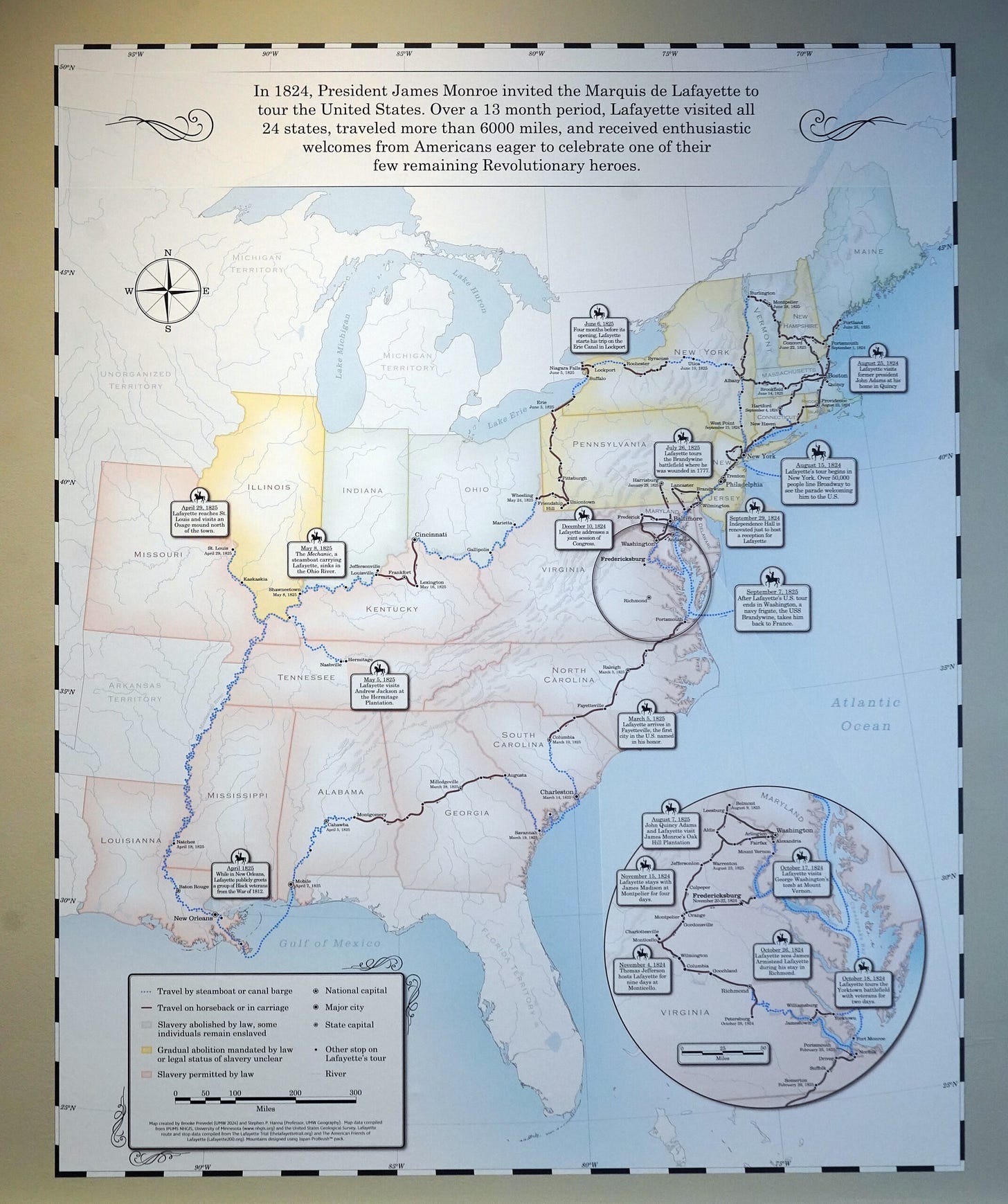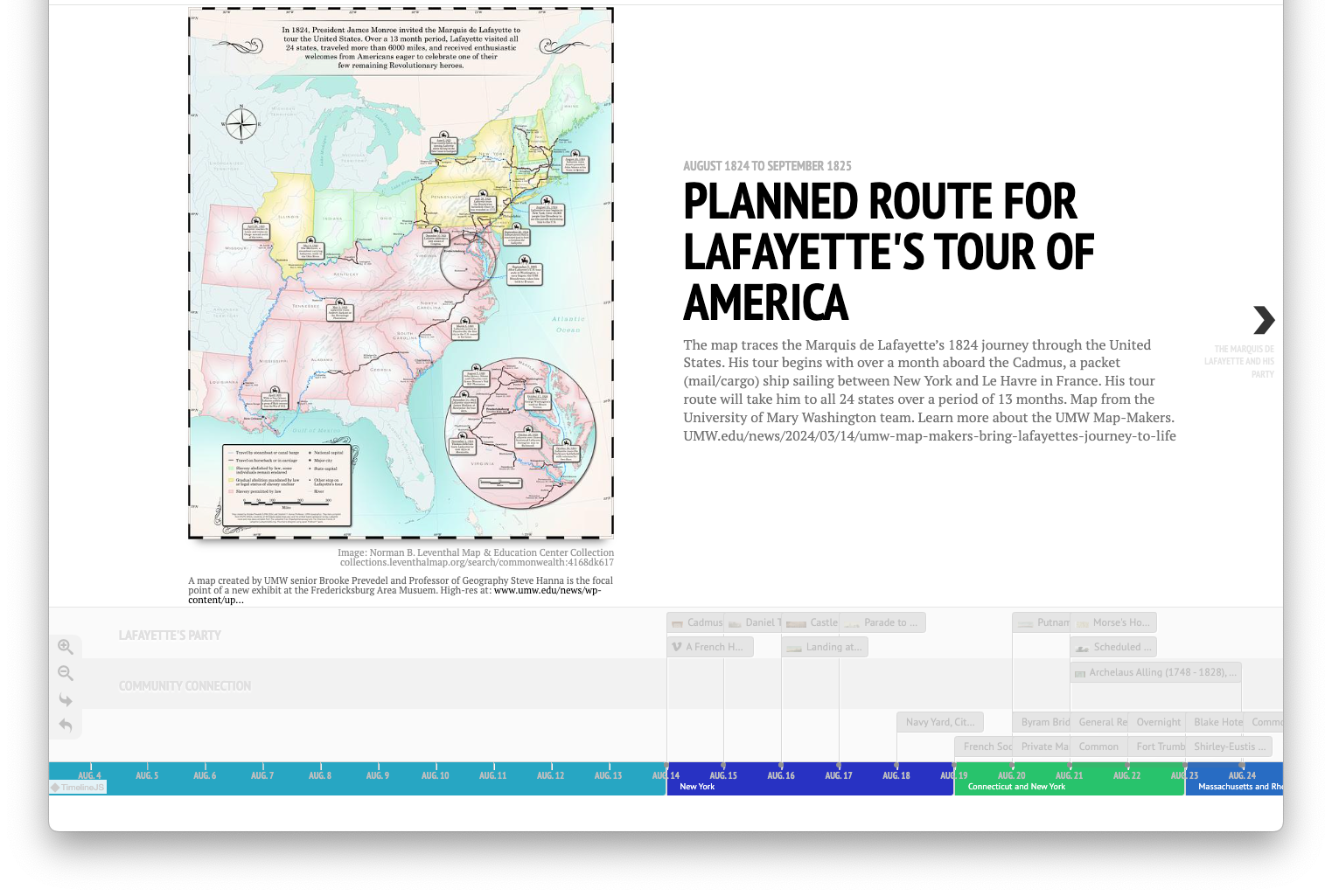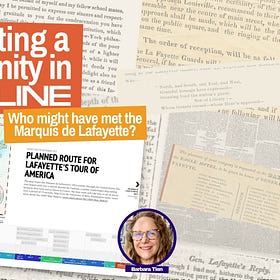1824-25 Bicentennial: Did Your Ancestors Meet the Marquis de Lafayette?
Where were your ancestors when the French general and veteran of the Revolutionary War toured the United States 200 years ago? Why not add your ancestors time and place to a timeline? (Updated)
I love building things. I give myself bonus points if I can turn a project into a “recipe” others can follow. This post describes a sideburner project I started a few weeks ago. While working on it, I realized there may be others interested in collaborating with me on it — or maybe building it into something else. That’s what we’re here for at Projectkin! Read on…
Background
This starts with the compelling story of a French aristocrat widely celebrated as an American hero: Gilbert du Motier, Marquis de Lafayette, or, as described more simply in our American history books, the Marquis de Lafayette. His compelling story is wound into our national narrative:
A dashing young French military officer comes to America and bonds with the charismatic leader of the continental army. He soon joins fight for the independence of this a colony from a rival nation. Forty years later, he returns to tour the nation, now expanded now to 24 states. The country welcomes him with a celebration in city and town he visits over 13 months. The national tour would be timed ahead of national celebrations for the 50th anniversary of the nation’s Declaration of Independence from Britain in 1826.
Were your ancestors alive then? Did they meet Lafayette?
Project: Baseline facts for interactive timelines & maps
Proper historians (which I am not) have extensively covered the facts of Lafayette’s visit. There’s little for me to add to the national story. As an American with roots in this continent predating this period, I was immediately curious whether any of my family’s ancestors might have greeted Lafayette during his tour. I have no diaries, letters, or other documentary evidence that my ancestors met the Marquis. That’s okay.
I soon realized that historical circumstances turned the project into a game to determine whether it was possible. This made me think deeply about how news traveled then and why someone might risk a journey of hours or days to meet the Frenchman. The project had become both fun and educational.

Lafayette’s journey in 1824, which covered so many American states, is widely documented and celebrated. A contemporaneous journal kept by his secretary, Auguste Levasseur, includes day-by-day activities. I could use these materials sources and focus on creating a generic tool anyone could use.
How YOU can play along
To play with “what-if” scenarios, I started with a generic JavaScript timeline created for journalists, developed for the Knight Lab, to help me contextualize stops on Lafayette’s 13-month tour. I wanted to see where his stops coincided with locations my ancestors might have lived—or traveled to—at the time.
The resulting tool is conceptually straightforward. It leverages existing data about Lafayette’s journey, structured into a spreadsheet. The spreadsheet data combines with the Knight Lab code to produce an interactive timeline. I used a variation on that data with the Google My Maps tool to complement it with an interactive map.
The bulk of the labor for this project is structuring Lafayette’s tour data into a spreadsheet. Fortunately, that data can easily be repurposed so that anyone can use it to see where their family members were at the time.
How it works
To find out where my ancestors might have encountered Lafayette’s tour, I first needed to capture each stop's location and contextualize it into the timeline.
Google Sheet
Since all of this data is subject to error and open to scrutiny, the base data is currently maintained in a single, publicly shared Google sheet with separate tabs for:
od1
This must be the first tab in your sheet. The terminology, format, and placement of the data required by the Knight Lab timeline tool.
I created a copy of that form with modifications for formatting so that I could see what I was doing, then ensured that each cell was mirrored on the od1 tab. This may not be necessary, but I found it very helpful.
Knight Lab Timeline
The Knight Lab at Northwestern University is a collaborative environment for developing “open-source, adaptable, and lightweight tools for media makers.” The TimelineJS tool I’ve used is among their most popular. I first learned about its use in Family History projects in this post by Robin Stewart for Genealogy Matters .
You’ll see my latest in-progress version below. Note that the timeline updates as changes are made to the spreadsheet. (Tap below to view and explore the timeline)1

Next Steps
While custom development would produce more elegant solutions, this approach is extensible—and importantly — free. I will continue to solidify the components so anyone can use the solution as a Project Recipe to see where their ancestors fit into Lafayette’s visit timeline. To get there, I still need to…
Update and curate highlights from Lafayette’s Itinerary: The original itinerary description was based on material drawn from Wikipedia and unstructured research. I have. now replaced that with detail graciously provided by the American Friends of Lafayette (AFL). This ☝️ updated version will be part of local celebrations in Lafayette, California in March and April 2025.
As of this update in February 2025, this is still a work in progress.
I’ve abandoned my original effort to combine the timeline with a map of Lafayette’s travels. The interactive AFL map at Lafayette200.org covers this challenge well. I highly recommend using Google Maps as a powerful free resource for any other project.
Want to play, too?
My schooling in American history was abysmal. Before starting this project, I had only a sketchy understanding of Lafayette’s journey or its impact on the country two hundred years ago.
Once I started thinking about my family's connection to this story, I was hooked.
To start the exploration, I filtered through my family tree's list of nearly a dozen Revolutionary War veterans. Only four were still alive during the months of the Marquis’ journey. I haven’t even begun to look for descendants.
To create a shared space, I added ribbon along the bottom labeled “Community Connection.” The idea is to have a shared place to list our connections in this story.2

Look like fun? Join me! I have a simple form with eight questions. That’s all I need to add your kin to the timeline! (Give me 24 hours, and I’ll post an update.)
Vision for extensions
After exploring this idea, I realized its basic mechanics would apply just as easily to ANY shared journey. All you would need are:
A baseline set of facts to use to create the timeline and map.
Incremental detail for individual lives. These might be for your family members or those of a shared community or social group.
The resulting visualization gives you the context to consider individual lives and shared experiences in a given time and place.
Examples
The Knight Lab team has published a dozen or more examples on their Timeline page; the difference is the idea of inserting your relative's stories during these events. Others can then reuse one expertly curated timeline to create custom variations. Consider, for example:
Arrivals at Ellis Island in New York, Angel Island in San Francisco Bay, or any other immigration point—anywhere in the world.
The Great Migration of African Americans from the rural South to the urban North, Midwest, and West, or Puritan emigrations from England.
Migrations all define important milestones in family history, and understanding how one family fits in a larger context could be helpful.
I’ve found many published battle timelines for WWII. Using this method, a private timeline created from a spreadsheet would give different family or community members the context to appreciate each other’s stories.
Any of these examples might be published as a public timeline. The difference is that this tool creates something where you can see when something else occurred on the same timeline. Plus, since the timeline structure can be shared, anyone can build on a timeline created by someone else.
As with any project, you need to appreciate how this combination of tools might be used to tell a story. As with any work published, your representations create expectations for the validity of the historical facts you present. You also incur obligations to respect copyrights, including citations and resource references.
Which reminds me: See an error? Let me know. I’ll get after it.
I wanted to share this draft with Projectkin Community Forum for several reasons.
First, I think this Lafayette version, in finished form, may be helpful to communities and social groups during this bicentennial year. The kind team at the American Friends of Lafayette are very supportive on this point.
Second, this project is a natural for collaborations. I look forward to your insights and contributions to using this tool to share other stories. For example, I think genealogy and historical societies may have some worthy projects.
Finally, this kind of project helps demonstrate how the narrative facts of any local, national, or international story can provide a context for family stories.
⮕ I’m all about ways to create that compelling honey-pot of stories extended family in your shared history.
So, what do YOU think?
Are you interested in working with me on this Lafayette story? Do you have another story like it? Let me know in the comments, or send me a message!
Update: Presentation of Lafayette Timeline Tool
In April 2025, I presented the timeline as a Project Recipe. In the following recording, you can see exactly how I put the timeline together.
Fun fact: It’s the same baseline tool as my Stories250 initiative. Once you have a hammer, everything looks like a nail.
Project Recipe » Lafayette’s Tour in a Timeline
If you participated in our live program, I hope you enjoyed it and the conversation with other members and participants. It’s an example of the kinds of programs we host here at Projectkin. We publish these “Recipe” projects to help you get your stories told — without the heavy lift of figuring out how to do it first. You can explore the full series of
Note that the timeline will not embed into Substack. Though it embeds nicely in many website builders, it works best using a full browser tab.
Please note that the unlabeled “ribbon” at the bottom of the timeline reflects the data I started with. The item labeled “Navy Yard,…” on August 18, 1824, for example, will be invisible in the final version.









I don’t believe I have ancestors who would have followed Lafayette’s tour but I love the potential applications of this. You are ‘playing’ with this idea. Perfect. Can I be an ‘outsider’ with viewing rights?
This is such an amazing project. I need to take a look at which of my ancestors might have been interested and possibly seen him. Thank you so much for not only sharing your work but including us.